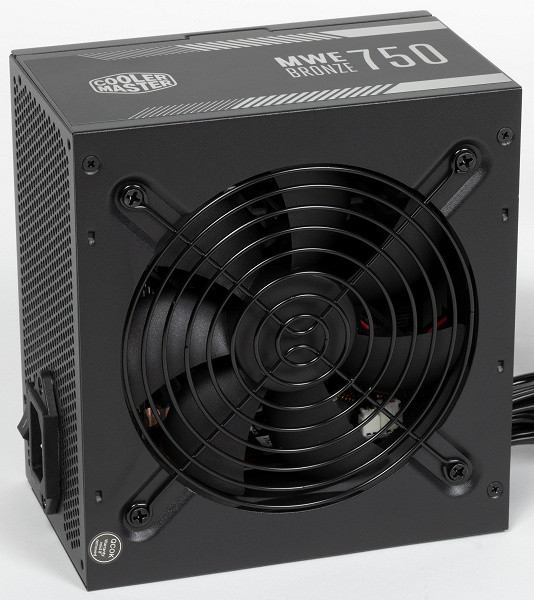
Immediately after the release of the “golden” model of the updated series of Cooler Master power supplies, we received another power supply from this company for testing, also marked V2. The MWE 750 Bronze V2 model has a more modest “bronze” certificate and less power compared to the previous version, which makes it almost a mid-budget solution. Although information about Cooler Master products is better available on the company's global website, the Russian version of the site has not been updated for a long time.
This PSU has a more modest configuration — its cooling system operates with a constantly rotating fan, there is no hybrid cooling mode. However, its more affordable price, approximately 8-9 thousand rubles at the time of publication of the review, makes it more attractive to a wide range of consumers.
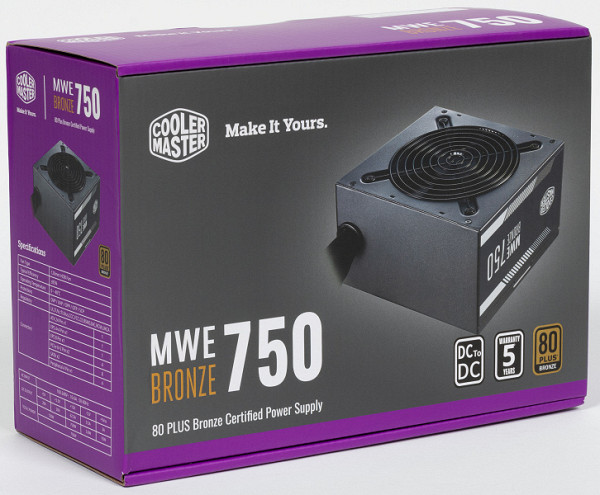
The packaging is made of durable cardboard with a matte finish and an illustration depicting the power supply itself. The design is dominated by black and purple shades.
Characteristics
All necessary information is indicated on the power supply case in full, including the power value of the +12VDC bus, which is 750 W. The ratio of +12VDC bus power to full power is 100%, which is an excellent indicator.

Wires and connectors
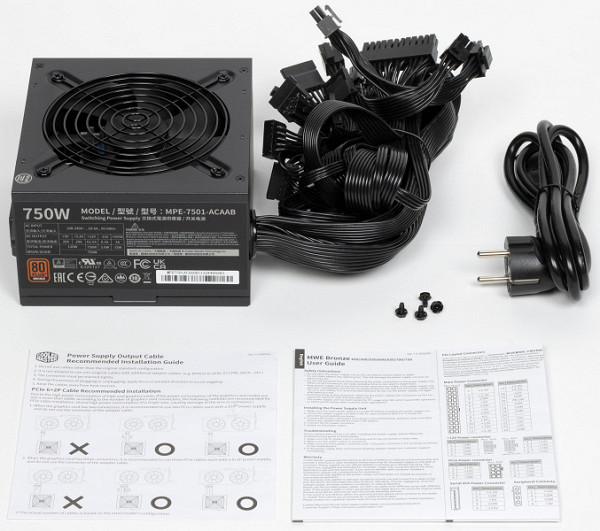
| Connector name | Number of connectors | Notes |
|---|---|---|
| 24 pin Main Power Connector | 1 | collapsible |
| 4 pin 12V Power Connector | — | |
| 8 pin SSI Processor Connector | 2 | on one cord, one detachable |
| 6 pin PCIe 1.0 VGA Power Connector | — | |
| 8 pin PCIe 2.0 VGA Power Connector | 4 | on 2 cords |
| 16 pin PCIe 5.0 VGA Power Connector | — | |
| 4 pin Peripheral Connector | 4 | |
| 15 pin Serial ATA Connector | 8 | on 2 cords |
| 4 pin Floppy Drive Connector | — |
Length of wires to power connectors
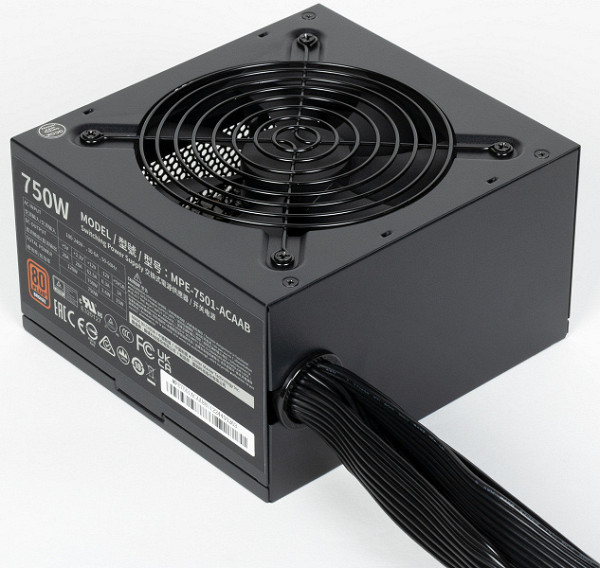
Cable length:
- 1 cable to main ATX connector: 61 cm
- 1 cable to the 8 pin SSI processor socket: 65 cm, plus 12 cm to the second similar connector
- 2 cables to the first power connector of the PCIe 2.0 VGA Power Connector: 55 cm, plus 12 cm to the second connector of the same type
- 2 cables to the first SATA Power Connector: 50 cm, plus 12 cm to the second, another 12 cm to the third and another 12 cm to the fourth same connector
- 1 cable to the first Peripheral Connector (“Molex”): 50 cm, plus 12 cm to the second, another 12 cm to the third and another 12 cm to the fourth of the same connector
The length of the wires is sufficient for full tower and larger cases with a top-mounted power supply. In cases up to 55 cm high with a bottom-mounted power supply, the wire length should also be sufficient: to the processor power connector — 65 cm. Most modern cases are suitable for this power supply.
All SATA Power connectors are angled, which may not be very convenient for drives placed on the back of the motherboard base. In addition to the standard cables for connecting three devices, it would be useful to have cables with 1-2 straight plug power connectors for devices in difficult to access areas.
Ribbon wires used in the power supply are more convenient to use as they do not attract dust.
Circuit design and cooling
The power supply is equipped with an active power factor correction and supports a wide range of input voltages from 100 to 240 volts. This guarantees stable operation even when the network voltage drops below the established standards.
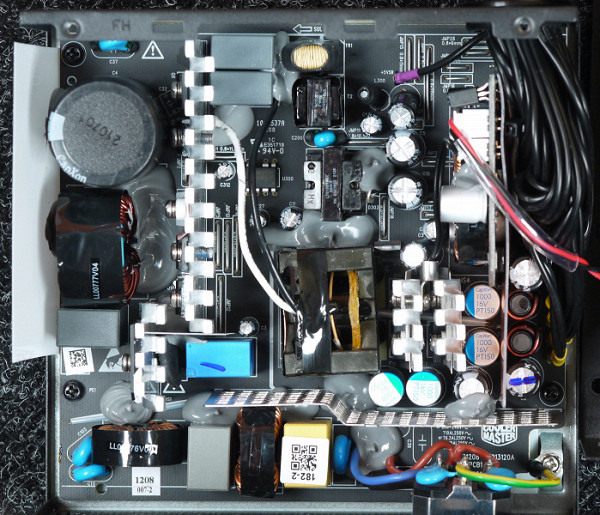
The design of the power supply follows modern trends: there is an active power factor correction, a synchronous rectifier for the +12VDC channel, as well as independent pulse-DC converters for the +3.3VDC and +5VDC lines.
The high-voltage semiconductor elements are located on a single heatsink, while the input rectifier has its own heat sink. The elements of the synchronous rectifier are placed on their own radiators, which are oriented vertically. This configuration provides efficient cooling of components and is one of the best options in terms of heat dissipation.
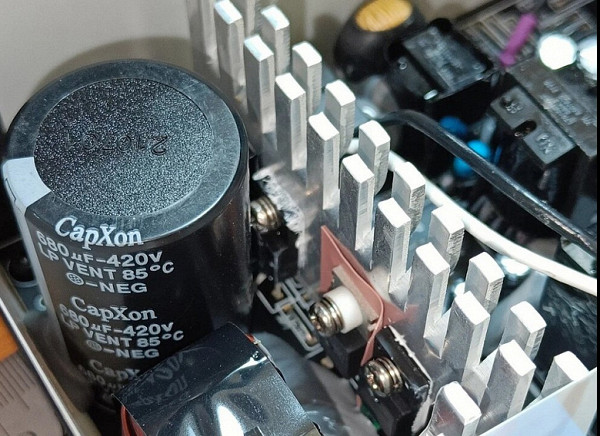

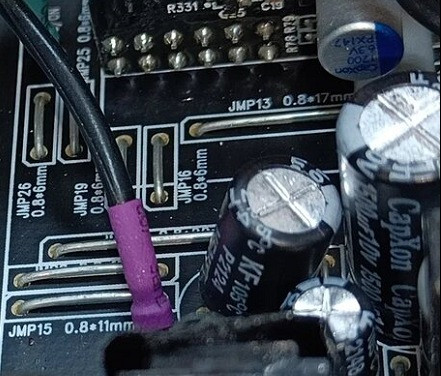
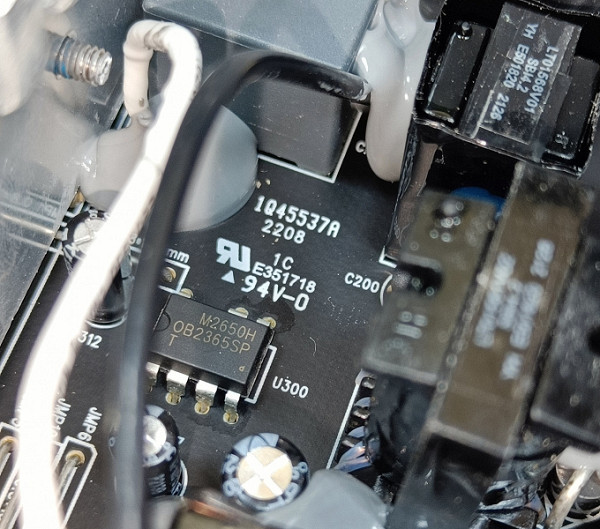

Independent sources of +3.3VDC and +5VDC are placed on an additional printed circuit board and, as a rule, are not equipped with additional heat sinks — this is standard practice for power supplies with active cooling.
The power supply uses Capxon brand capacitors. For a product in this price segment, this is a completely acceptable solution.
In addition, the device contains a significant number of polymer capacitors.
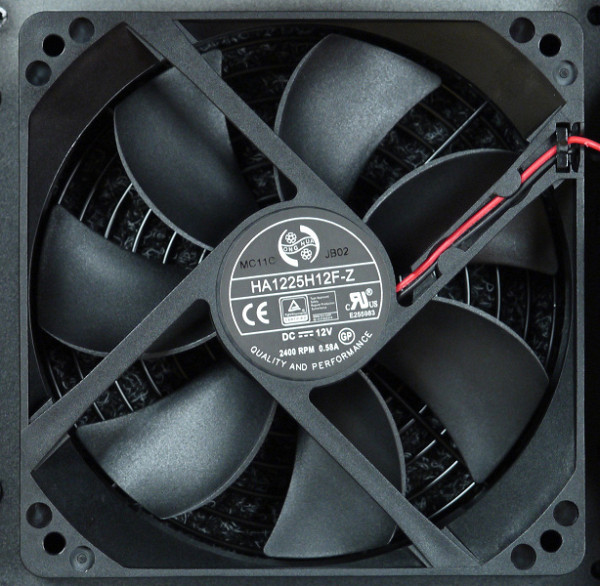
The power supply is equipped with a 120mm HA1225H12F-Z fan with a speed of 2300 rpm, using a fluid dynamic bearing, which ensures long service life. This fan is manufactured by Dongguan Honghua Electronic Technology. The connection is made via a two-wire connector.
This fan is very common and is found in many models, including more expensive options. Thanks to its standard size, it can be easily replaced if necessary.
Electrical Characteristics Measurement
We then proceed to analyze the electrical characteristics of the power supply using a multi-function test bench and other necessary equipment.
The deviation of output voltages from the nominal value is coded by the following color designation:
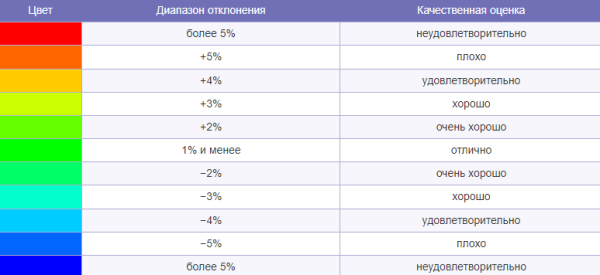
Operating at maximum power
The first stage of testing is long-term operation of the power supply at maximum load. This test step ensures that the power supply is operating reliably.

Cross-load characteristic
The next stage of instrumental testing is the construction of a cross-load characteristic (CLC) and its representation on a quarter-plane. The ordinate axes are limited by the maximum bus power of 3.3&5 V, and the abscissa axes are limited by the maximum bus power of 12 V. At each point, the measured voltage value is indicated by a color marker depending on the deviation from the nominal value.
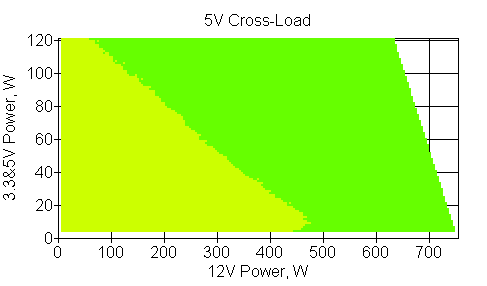
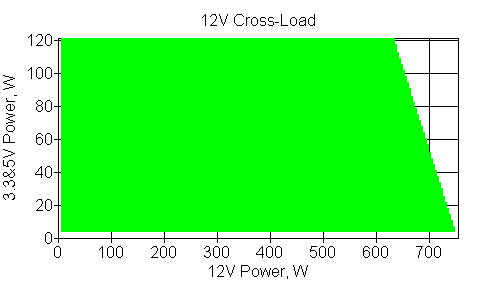
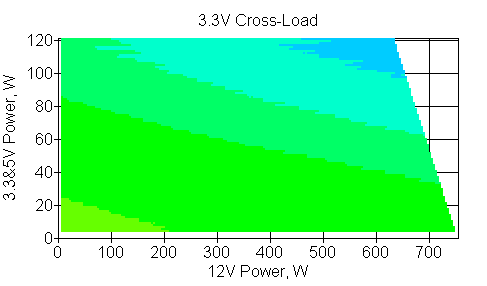
KNKh allows you to determine the permissible load level, especially on the +12VDC channel. Voltage deviations from the nominal value along this channel do not exceed 1% over the entire power range, which is a very good result. What was especially pleasing was that the deflection increases at low loads, which indicates stability at high loads.
With a typical power distribution, deviations from the nominal do not exceed 3% on the +3.3VDC and +5VDC channels, as well as 1% on the +12VDC channel.
This power supply model is perfect for modern powerful systems due to the high practical load capacity of the +12VDC channel.
Load capacity
In the following test, we determine the maximum power that can be supplied through the corresponding connectors with a normal voltage deviation of 3 or 5 percent of the nominal voltage.

In the case of a video card with a single power connector, the maximum power over the +12VDC channel is at least 150 W with a deviation within 3%.

In the case of a video card with two power connectors when using one power cord, the maximum power over the +12VDC channel is at least 250 W with a deviation within 3%.

In the case of a video card with two power connectors, when using two power cords, the maximum power over the +12VDC channel is at least 350 W with a deviation within 3%, which allows the use of very powerful video cards.

When loaded through three PCIe 2.0 connectors, the maximum power over the +12VDC channel is at least 650 W with a deviation within 3%.

When loaded through the processor power connector, the maximum power through the +12VDC channel is at least 250 W with a deviation within 3%. This is quite enough for typical systems that have only one connector on the motherboard for powering the processor.

When loaded through the processor power connector, the maximum power through the +12VDC channel is at least 250 W with a deviation within 3%. This is quite enough for typical systems that have only one connector on the motherboard for powering the processor.

In the case of a motherboard, the maximum power over the +12VDC channel is at least 150 W with a deviation of 3%. Since the board itself consumes within 10 W on this channel, high power may be required to power expansion cards — for example, for video cards without an additional power connector, which usually have a consumption within 75 W.
Cost-effective and efficient
When assessing the efficiency of computer power supplies, there are two approaches. The first approach evaluates the power supply as a separate electrical energy converter, minimizing the resistance of the power transmission line to the load. However, in real conditions, each power supply is connected to a limited set of connectors, which makes the test results of little use.
The second approach, based on the concept of efficiency, measures the power dissipation and energy consumption of the power supply over a certain time under constant load. This method allows you to evaluate the actual differences in power consumption between different power supply models and calculate the economic benefits of using more efficient power supplies.
We identify typical power options and correlate them with the number of connectors in order to bring the method of measuring efficiency closer to real-life conditions of use. This allows you to evaluate the efficiency of different power supplies under completely identical conditions.
| Load through connectors | 12VDC, W | 5VDC, W | 3.3VDC, W | Total power, W |
|---|---|---|---|---|
| main ATX, processor (12 V), SATA | 5 | 5 | 5 | 15 |
| main ATX, processor (12 V), SATA | 80 | 15 | 5 | 100 |
| main ATX, processor (12 V), SATA | 180 | 15 | 5 | 200 |
| Main ATX, CPU (12V), 6-pin PCIe, SATA | 380 | 15 | 5 | 400 |
| Main ATX, CPU (12V), 6-pin PCIe (1 cord with 2 connectors), SATA | 480 | 15 | 5 | 500 |
| main ATX, processor (12 V), 6-pin PCIe (2 cords per 1 connector), SATA | 480 | 15 | 5 | 500 |
| Main ATX, CPU (12 V), 6-pin PCIe (2 cords x 2 connectors), SATA | 730 | 15 | 5 | 750 |
The results obtained look like this:

| Power dissipation, W | 15 W | 100 W | 200 W | 400 W | 500 W (1 cord) | 500 W (2 cords) | 750 W |
|---|---|---|---|---|---|---|---|
| Cougar BXM 700 | 12.0 | 18.2 | 26.0 | 42.8 | 57.4 | 57.1 | |
| Cooler Master Elite 600 V4 | 11.4 | 17.8 | 30.1 | 65.7 | 93.0 | ||
| Cougar GEX 850 | 11.8 | 14.5 | 20.6 | 32.6 | 41.0 | 40.5 | 72.5 |
| Cooler Master V650 SFX | 7.8 | 13.8 | 19.6 | 33.0 | 42.4 | 41.4 | |
| Chieftec BDF-650C | 13.0 | 19.0 | 27.6 | 35.5 | 69.8 | 67.3 | |
| XPG Core Reactor 750 | 8.0 | 14.3 | 18.5 | 30.7 | 41.8 | 40.4 | 72.5 |
| Deepcool DQ650-M-V2L | 11.0 | 13.8 | 19.5 | 34.7 | 44.0 | ||
| Deepcool DA600-M | 13.6 | 19.8 | 30.0 | 61.3 | 86.0 | ||
| Fractal Design Ion Gold 850 | 14.9 | 17.5 | 21.5 | 37.2 | 47.4 | 45.2 | 80.2 |
| XPG Pylon 750 | 11.1 | 15.4 | 21.7 | 41.0 | 57.0 | 56.7 | 111.0 |
| Chieftronic PowerUp GPX-850FC | 12.8 | 15.9 | 21.4 | 33.2 | 39.4 | 38.2 | 69.3 |
| MSI MPG A750GF | 11.5 | 15.7 | 21.0 | 30.6 | 39.2 | 38.0 | 69.0 |
| Chieftronic PowerPlay GPU-850FC | 12.0 | 15.9 | 19.7 | 28.1 | 34.0 | 33.3 | 56.0 |
| Cooler Master MWE Gold 750 V2 | 12.2 | 16.0 | 21.0 | 34.6 | 42.0 | 41.6 | 76.4 |
| XPG Pylon 450 | 12.6 | 18.5 | 28.4 | 63.0 | |||
| Chieftronic PowerUp GPX-550FC | 12.2 | 15.4 | 21.6 | 35.7 | 47.1 | ||
| Chieftec BBS-500S | 13.3 | 16.3 | 22.2 | 38.6 | |||
| Cougar VTE X2 600 | 13.3 | 18.3 | 28.0 | 49.3 | 64.2 | ||
| Thermaltake GX1 500 | 12.8 | 14.1 | 19.5 | 34.8 | 47.6 | ||
| Thermaltake BM2 450 | 12.2 | 16.7 | 26.3 | 57.9 | |||
| Super Flower SF-750P14XE | 14.0 | 16.5 | 23.0 | 35.0 | 42.0 | 44.0 | 76.0 |
| XPG Core Reactor 850 | 9.8 | 14.9 | 18.1 | 29.0 | 38.4 | 37.0 | 63.0 |
| Asus TUF Gaming 750B | 11.1 | 13.8 | 20.7 | 38.6 | 50.7 | 49.3 | 93.0 |
| Chieftronic BDK-650FC | 12.6 | 14.3 | 20.4 | 41.1 | 53.5 | 50.6 | |
| Cooler Master XG Plus 750 Platinum | 13.8 | 14.2 | 18.9 | 36.5 | 43.0 | 40.0 | 61.1 |
| Chieftec GPC-700S | 15.6 | 21.4 | 30.9 | 63.5 | 84.0 | ||
| Zalman ZM700-TXIIv2 | 12.5 | 19.5 | 30.8 | 62.0 | 83.0 | 80.0 | |
| Cooler Master V850 Platinum | 17.8 | 20.1 | 24.6 | 34.5 | 38.3 | 37.8 | 58.5 |
| Chieftec CSN-650C | 10.7 | 12.5 | 17.5 | 32.0 | 43.5 | ||
| Powerman PM-300TFX | 12.0 | 20.0 | 38.2 | ||||
| Chieftec GPA-700S | 13.4 | 19.3 | 30.3 | 64.1 | 86.5 | ||
| XPG Probe 600W | 12.8 | 19.6 | 29.5 | 58.0 | 80.0 | ||
| Super Flower Leadex VII XG 850W | 11.7 | 14.5 | 18.4 | 26.7 | 32.2 | ||
| Cooler Master V850 Gold i Multi | 10.8 | 14.6 | 19.8 | 32.0 | 37.0 | ||
| Cooler Master V850 Gold V2 WE | 11.3 | 13.6 | 17.2 | 29.0 | 36.2 | 35.6 | 62.5 |
| Cooler Master MWE 750 Bronze V2 | 18.0 | 19.3 | 23.2 | 41.8 | 53.4 | 54.2 | 99.1 |
This model has average efficiency in all tested modes; it is a quite typical representative of power supplies with the 80Plus Bronze certificate level.
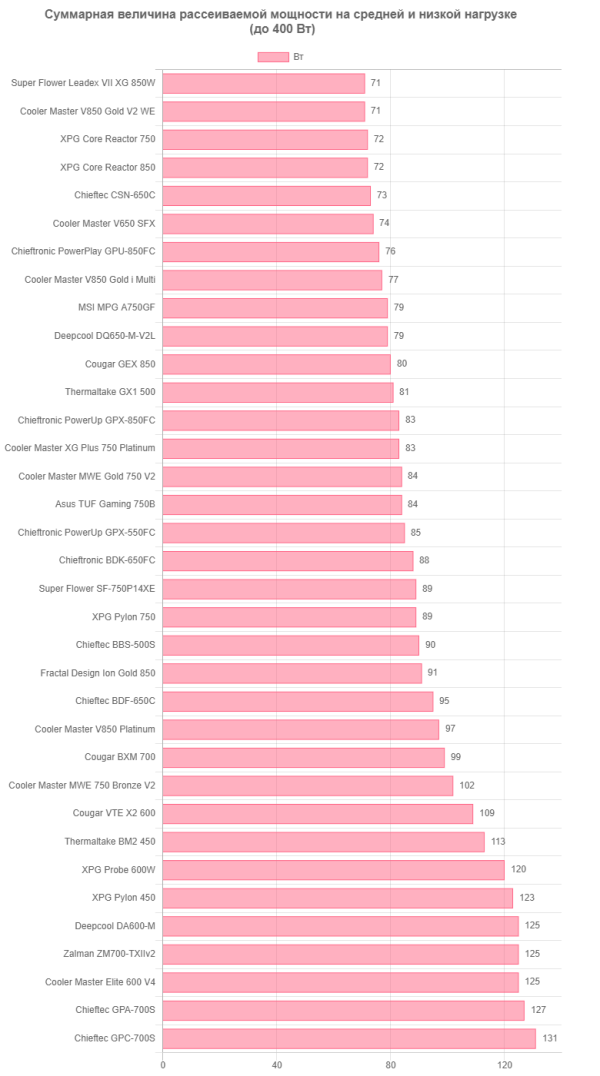
In terms of overall efficiency at low and medium power, this model occupies a far from leading position in our list at the time of testing.
| Computer energy consumption per year, kWh | 15 W | 100 W | 200 W | 400 W | 500 W (1 cord) | 500 W (2 cords) | 750 W |
|---|---|---|---|---|---|---|---|
| Cougar BXM 700 | 237 | 1035 | 1980 | 3879 | 4883 | 4880 | |
| Cooler Master Elite 600 V4 | 231 | 1032 | 2016 | 4080 | 5195 | ||
| Cougar GEX 850 | 235 | 1003 | 1933 | 3790 | 4739 | 4735 | 7205 |
| Cooler Master V650 SFX | 200 | 997 | 1924 | 3793 | 4751 | 4743 | |
| Chieftec BDF-650C | 245 | 1042 | 1994 | 3815 | 4991 | 4970 | |
| XPG Core Reactor 750 | 202 | 1001 | 1914 | 3773 | 4746 | 4734 | 7205 |
| Deepcool DQ650-M-V2L | 228 | 997 | 1923 | 3808 | 4765 | ||
| Deepcool DA600-M | 251 | 1049 | 2015 | 4041 | 5133 | ||
| Fractal Design Ion Gold 850 | 262 | 1029 | 1940 | 3830 | 4795 | 4776 | 7273 |
| XPG Pylon 750 | 229 | 1011 | 1942 | 3863 | 4879 | 4877 | 7542 |
| Chieftronic PowerUp GPX-850FC | 244 | 1015 | 1940 | 3795 | 4725 | 4715 | 7177 |
| MSI MPG A750GF | 232 | 1014 | 1936 | 3772 | 4723 | 4713 | 7174 |
| Chieftronic PowerPlay GPU-850FC | 237 | 1015 | 1925 | 3750 | 4678 | 4672 | 7061 |
| Cooler Master MWE Gold 750 V2 | 238 | 1016 | 1936 | 3807 | 4748 | 4744 | 7239 |
| XPG Pylon 450 | 242 | 1038 | 2001 | 4056 | |||
| Chieftronic PowerUp GPX-550FC | 238 | 1011 | 1941 | 3817 | 4793 | ||
| Chieftec BBS-500S | 248 | 1019 | 1947 | 3842 | |||
| Cougar VTE X2 600 | 248 | 1036 | 1997 | 3936 | 4942 | ||
| Thermaltake GX1 500 | 244 | 1000 | 1923 | 3809 | 4797 | ||
| Thermaltake BM2 450 | 238 | 1022 | 1982 | 4011 | |||
| Super Flower SF-750P14XE | 254 | 1021 | 1954 | 3811 | 4748 | 4765 | 7236 |
| XPG Core Reactor 850 | 217 | 1007 | 1911 | 3758 | 4716 | 4704 | 7122 |
| Asus TUF Gaming 750B | 229 | 997 | 1933 | 3842 | 4824 | 4812 | 7385 |
| Chieftronic BDK-650FC | 242 | 1001 | 1931 | 3864 | 4849 | 4823 | |
| Cooler Master XG Plus 750 Platinum | 252 | 1000 | 1918 | 3824 | 4757 | 4730 | 7105 |
| Chieftec GPC-700S | 268 | 1064 | 2023 | 4060 | 5116 | ||
| Zalman ZM700-TXIIv2 | 241 | 1047 | 2022 | 4047 | 5107 | 5081 | |
| Cooler Master V850 Platinum | 287 | 1052 | 1968 | 3806 | 4716 | 4711 | 7083 |
| Chieftec CSN-650C | 225 | 986 | 1905 | 3784 | 4761 | ||
| Powerman PM-300TFX | 237 | 1051 | 2087 | ||||
| Chieftec GPA-700S | 249 | 1045 | 2017 | 4066 | 5138 | ||
| XPG Probe 600W | 244 | 1048 | 2010 | 4012 | 5081 | ||
| Super Flower Leadex VII XG 850W | 234 | 1003 | 1913 | 3738 | 4662 | ||
| Cooler Master V850 Gold i Multi | 226 | 1004 | 1925 | 3784 | 4704 | ||
| Cooler Master V850 Gold V2 WE | 230 | 995 | 1903 | 3758 | 4697 | 4692 | 7118 |
| Cooler Master MWE 750 Bronze V2 | 289 | 1045 | 1955 | 3870 | 4848 | 4855 | 7438 |
Temperature
The thermal load of capacitors when operating at power up to maximum is at a low level.

Acoustic ergonomics
When conducting a study of the noise level of power supplies, the following measurement technique was used. The power supply was installed on a flat surface with the fan facing up. Above it, at a distance of 0.35 meters, a measuring microphone of the Oktava 110A-Eco sound level meter was placed to measure the noise level. The load on the power supply was carried out using a special stand with a silent operating mode. The power supply was operated at constant power for 20 minutes, after which the noise level was measured.
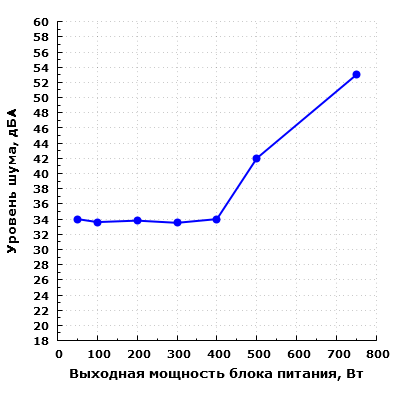
When using a power supply with a constantly rotating fan in the power range up to 400 W, the noise level is at an average level for residential premises during the daytime. However, even at minimum power, the noise does not reduce significantly, remaining at approximately the same level, which makes this model not suitable for those who prefer absolute silence.
When using a power supply in the power range from 500 to 750 W, the noise level exceeds 40 dBA, which can be described as a high noise level for residential premises during the daytime.
Thus, from an acoustic point of view, this model provides a comfortable noise level with an output power of up to 400 W.
In the future, it may be worth considering installing a less noisy fan, especially if the load on the power supply remains within 400 W.
Consumer qualities
The Cooler Master MWE 750 Bronze V2 power supply has good consumer characteristics. The high load capacity of the +12VDC channel allows its use in powerful systems with multiple video cards. Despite poor acoustic ergonomics at high power, at loads up to 400 W the noise remains at an acceptable level. However, at 500 W, the noise becomes noticeable and unpleasant, although this is typical for components with such consumption. The wires are long enough for most modern cases, and their ribbon design makes them easy to use.
Results
The Cooler Master MWE 750 Bronze V2 power supply demonstrates average efficiency. It is equipped with a long-life hydrodynamic bearing fan and reliable Capxon capacitors. As a result of passing all the tests, the power supply demonstrated stable performance, which is a positive thing. Overall, this model does not claim to be a leader, but is a decent mid-level product.
On the other hand, in this series there are models with a power of 450 W, which are likely to be more in demand for most users. Considering that the use of two video cards is becoming less and less popular, lower power supplies, for example 450-500 W, may well meet the needs of modern systems with a single video card and a mid-range processor.
